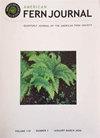瓦努阿图塔菲亚省石松和蕨类植物的民族植物学和方言名称
IF 0.9
4区 生物学
Q4 PLANT SCIENCES
引用次数: 0
摘要
摘要2014年至2021年,我们在瓦努阿图塔菲亚省进行了广泛的实地调查,作为植物和真菌长期植物区系研究的一部分,并分析了森林结构和植物多样性的变化,以应对5级气旋帕姆。作为这项工作的一部分,我们记录了10种石松植物和88种蕨类植物的方言名称和/或用途。当地的植物名称记录在Aneityum、Futuna和Tanna岛屿特有的语言中,包括Anejom、~ Futuna- aniwa、Kwamara、Nafe、Naka、Netwar、na淮和Whitesands。尼瓦努阿图土著专家报告的用途包括:身体装饰、文化/精神、装饰、服装、食品/食品制备、手工艺品、医药和纤维/建筑。本文章由计算机程序翻译,如有差异,请以英文原文为准。
Ethnobotany and Vernacular Names of the Lycophytes and Ferns of Tafea Province, Vanuatu
Abstract. We conducted extensive fieldwork in the Tafea Province of Vanuatu from 2014 to 2021 as part of a long-term floristic study of plants and fungi as well as analyses of changes in forest structure and plant diversity in response to the category 5 cyclone Pam. As part of this work, we documented the vernacular names and/or uses of 10 species of lycophytes and 88 species of ferns. Vernacular plant names were documented in the languages endemic to the islands of Aneityum, Futuna, and Tanna, including Anejom, ∼ Futuna-Aniwa, Kwamara, Nafe, Naka, Netwar, Nahuai, and Whitesands. The uses reported by indigenous, Ni-Vanuatu, experts included: body decoration, cultural/spiritual, ornamental, clothing, food/food preparation, handicrafts, medicine, and fiber/construction.
求助全文
通过发布文献求助,成功后即可免费获取论文全文。
去求助
来源期刊

American Fern Journal
生物-植物科学
CiteScore
1.20
自引率
0.00%
发文量
28
审稿时长
6 months
期刊介绍:
The American Fern Journal is a peer-reviewed journal focused on the biology of ferns and lycophytes.
 求助内容:
求助内容: 应助结果提醒方式:
应助结果提醒方式:


